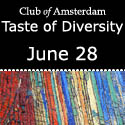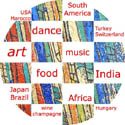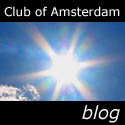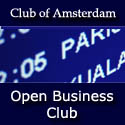
Welcome to the Club of Amsterdam Journal. Join us for a special evening: Taste of Diversity on Thursday, June 28 is about creating greater awareness of cultural diversity and strengthening, promoting and sharing of cultural wealth. The idea of “intercultural dialogue” takes as its starting point the recognition of difference and multiplicity of the world in which we live. These differences of opinion, viewpoint, and values exist not only within each individual culture but also between cultures. ‘Dialogue’ seeks to approach these multiple viewpoints with a desire to understand and learn from those that do not see the world in the same way as ourselves. An effective ‘dialogue’, therefore, is an enriching and opening interaction which encourages the respectful sharing of ideas and an exploration of the different thought-processes through which the world is perceived and understood. In an increasingly globalised and interdependent world, where encountering cultural difference can scarcely be avoided, the ability to enter into a tolerant and respectful dialogue is a vital skill for nations, communities, and individuals. This evening has two parts: the Conference & the Cultural Market |
Felix Bopp, editor-in-chief
Culture and Trade
 | By UNESCO The cultural industries continue to grow steadily apace. They include publishing, music, audiovisual technology, electronics, video games and the Internet. Their international dimension gives them a determining |
role for the future in terms of freedom of expression, cultural diversity and economic development. Although the globalization of exchange and new technologies opens up exciting new prospects, it also creates new types of inequality.
The world map of cultural industries reveals a yawning gap between North and South. This can only be counteracted by strengthening local capacities and facilitating access to global markets at national level by way of new partnerships, know-how, control of piracy and increased international solidarity of every kind.
Introduction
Over the past 50 years, the general world economic trend has been towards open markets: world exports increased from 8% to 27% of world GDP between 1950 and 1998. Total trade in 1997 was 14-times the level of 1950. This expansion of international trade has been accompanied by comprehensive multilateral and bilateral trade agreements establishing the conditions for eliminating tariff and nontariff barriers to the circulation of goods, services and investments. The end of the Uruguay Round in 1994 initiated a new era of global economics, characterised by the emergence of trading blocks – from the highly integrated European Union to the less consolidated, but still evolving, ASEAN (Association of South East Asian Nations), NAFTA (North American Free Trade Agreement) or MERCOSUR (the Southern Cone Common Market). More recently, the evolution of telecommunications and new technologies has dramatically reduced the cost of providing commercial services. The World Wide Web is also transforming the nature of products and services.
Market integration allows consumers to buy goods from all over the world in their local shops and supermarkets. While local businesses must compete with these foreign goods on their home turf, they also have new opportunities to develop their export markets by selling in a multitude of other countries.
Cultural goods and services are no exception to these new patterns of production, consumption and trade. Cultural markets are increasingly going global; trade in cultural goods has multiplied by five between 1980 and 1998. Cultural (content) industries are growing exponentially and will continue to do so in the future; as we will see, they are to become a central pillar of the information society, also referred to as the “knowledge society”.
As consumption of cultural goods and services spreads all over the world, production itself tends to concentrate. This results in an oligopolistic market with a highly asymmetric structure. The effects of this market profile are as yet unknown: while we are aware that a large share of the cultural products circulating in most countries are produced elsewhere, we know very little about the impact of this global cultural market on citizens, audiences, businesses and governments.
In this context, the following considerations arise:
- First, culture has moved to the forefront. The past few years have seen the emergence of a powerful interest in culture resulting from a combination of diverse phenomena such as globalisation, regional integration processes and cultures claiming their right to express themselves; all this in a context where cultural industries are progressively taking over traditional forms of creation and dissemination and bringing about changes in cultural practices.
- Second, the issue of “culture and trade“ has now acquired prime strategic significance. Cultural goods and services convey and construct cultural values, produce and reproduce cultural identity and contribute to social cohesion; at the same time they constitute a key free factor of production in the new knowledge economy. This makes negotiations in the cultural field extremely controversial and difficult. As several experts point out, no other industry has generated so much debate on the political economic and institutional limits of the regional and global integration processes or their legitimacy. When culture is put on the table, it often prompts complex discussions on the relationship between the economic and non-economic value of things, that is, the value attributed to those things that do not have an assigned price (such as identity, beauty or the meaning of life).
- Third, some governments understand that international trade law is exercising growing pressure on their ability to influence the production and distribution of cultural goods and services within their borders. This has increasingly polarised positions in trade negotiations whenever they deal directly or indirectly with cultural issues. This mounting tension was revealed in the final discussions of the Uruguay Round in 1994, acquired momentum during the negotiations on the Multilateral Agreement on Investments (OCDE 1995-1998), and was crystallised in the preparations for the WTO Ministerial Meeting in Seattle (USA) in 1999.
- Fourth, and as stated in the 1999 UNDP Human Development Report, twothirds of humanity do not benefit from the new model of economic growth based on the expansion of international trade and the development of new technologies, and are excluded from the construction of the information society. This situation reveals gaps in terms of individual countries’ capacities and resources to produce cultural goods and services. In many developing or small countries, these capabilities are actually shrinking. As a consequence, trade flows of cultural goods are unbalanced, heavily weighted in one direction, and cultural industries show great disparities in their structures, both within and between the various regional trade blocks.
However, world trade rules are still in the making. Just like in any major social, cultural and political change, rules are gradually established. For instance, trade partners have been unable to agree on how far investment should be liberalised, or on the necessity (or lack thereof) of creating legal frameworks to regulate new industries such as electronic commerce. In short, trade rules are evolving and being transformed; there is still work to be done.
It is generally admitted that part of the problem is the lack of shared concepts and definitions. This might be explained by the fact that actors in trade negotiations tend to read and interpret the same facts and situations in opposite ways. Not only their economic interests may differ, but their views, values and priorities also tend to diverge.
Therefore, a better understanding of the nature of the current changes is crucial for all countries, but particularly for developing ones. They must look forward and identify areas of strategic interest for their cultural sectors, and, overall, help shape more forcefully the global trade structure of cultural goods and services.
Special Event: Taste of Diversity – Thursday, June 28
| Taste of Diversity Thursday, June 28, 2007 Location: PricewaterhouseCoopers, Thomas R. Malthusstraat 5, 1066 JR Amsterdam This evening has two parts: Conference & Cultural Market Conference Registration: 18:30-19:00, Conference: 19:00-21:15 With H.E. Gábor Szentiványi, Ambassador of Hungary to the Netherlands Central Europe: Values and traditions Humberto Schwab, Director, Club of Amsterdam, Innovation Philosopher, Owner, Humberto Schwab Filosofia Cultures as methods of realizing the radical human challenge Iclal Akcay, Journalist, Turkey Lives of muslim women, different perspectives Florangel Maritza Russel, Chairwoman of the Association of Black Business Women in the Netherlands (ZZVN ) The diversity of black women in The Netherlands and Consul General Marjorie A. Ames, U.S. Consulate General in Amsterdam Moderated by Peter C. van Gorsel, Director of the Institute for Media and Information Management, Hogeschool van Amsterdam |
| Cultural Market 18:30-23:30FREE Entrance Location MapThe market is outdoors or – depending on the weather – indoors.with food, drinks, music, dance etc from different Cultures and Continents. Live music, Brazilian dance, yoga, wines from Hungary and Switzerland, caipirinha, raclette, Indian dishes, goulash, art workshops and more |
  |
News about the future of Cultural Diversity

Europe 2007: 27 members, but no clear perspective
“The current situation in the European affairs consists in a real deadlock; either Europe will advance united and strong in its multicultural variety, as we suggest, or a very bad European experience will strike us again: around a reunified German fatherland, an exacerbated nationalism would help a new political elite fanaticize the masses against what will be depicted as “Other”. ” – Prof. Dr. Muhammad Shamsaddin Megalommatis

Islam in Europe – The Exception to the Rule?
by Olivier Roy
“The development of Islam in Europe is taking place at the grassroots level, not in books or resolutions. Instead of fighting, we need to accompany the autonomizing of religions, which means that political forces must not interfere with theology (that would mark the end of the separation of the State and the Church). On the contrary, we should support the religious independence of European Islam from the cultures of the relevant countries of origin.”
Club of Amsterdam blog
 | Club of Amsterdam blog http://clubofamsterdam.blogspot.com June 4: Universal Declaration of Human Values April 20: Aspects of Mobility |
News about the Future

Wireless power transfer
MIT team experimentally demonstrates wireless power transfer that is potentially useful for powering laptops and cell phones without cords. It’s called WiTricity.
Imagine a future in which wireless power transfer is feasible: cell phones, household robots, mp3 players, laptop computers and other portable electronics capable of charging themselves without ever being plugged in, freeing us from that final, ubiquitous power wire. Some of these devices might not even need their bulky batteries to operate.WiTricity is based on using coupled resonant objects. Two resonant objects of the same resonant frequency tend to exchange energy efficiently, while interacting weakly with extraneous off-resonant objects. A child on a swing is a good example of this. A swing is a type of mechanical resonance, so only when the child pumps her legs at the natural frequency of the swing is she able to impart substantial energy.

India’s Textile and Apparel Industry: Opportunities for Sourcing and Collaboration
India ranks among the top target countries for any company sourcing textiles and apparel. Indeed, apart from China, no other country can match the size, spread, depth, and competitiveness of the Indian textile and apparel industry. Moreover, the global elimination of quotas at the end of 2004 has greatly enhanced the opportunities for sourcing from India.
This special report focuses on the opportunities which India now offers as a source of textiles and apparel. Based on a detailed examination of the performance of a large number of apparel and home textile products in the US and EU markets in 2005, the report identifies those which offer the greatest scope for sourcing from India.
AlphaSphere
| For more than 10 years sha. has been working on a multi-layered piece of work that puts people´s perception back into the centre. The passion for discovering wider horizons of perception can be felt in his multifaceted explorations: sha. touches all of people´s senses, allowing them to plunge into his “spheres” where they transcend conventional limits of space and time. AlphaSphere Different perceptional dimensions blend into one holistic multisensory experience. Hearing, seeing, feeling – AlphaSphere allows you to experience your senses not as separate sensations, but as a whole. Colour, shape and light in unique combination with sound, vibrations and warmth lead to ultra-deep relaxation. You feel light and free, both physically and mentally. Rational and analytical thinking fade into the background. All feeling is directed towards your inner self.The AlphaExperience is embedded in a “spaceless space”.  Spa & Wellness AlphaSphere’s deep relaxation effects such as feelings of well-being, letting go and inner calm are highly appreciated at wellness facilities.Therapie & Coaching The holistic flow experience with AlphaSphere is an ideal beginning for various personal development and therapeutic approaches.Empowerment Managers and athletes focus on the invigorating aspects of AlphaSphere, using it as a source of energy to reach high performance and mental serenity.Design & Lifestyle A real eye and ear catcher, it is an aesthetic delight for all senses. A strikingly different interior design object that inspires, enhances creativity and creates a new sense of pleasure.   |
Recommended Book

Culture and Psychology
by David Matsumoto, Linda Juang
David Matsumoto and new co-author Linda Juang show students the importance of culture in explaining and understanding human behavior in this new edition of the market-leading text, CULTURE AND PSYCHOLOGY. Using a cross-cultural framework to evaluate psychology, and reflecting the most current research, the authors engage students by inviting them to understand and raise questions about traditional knowledge and theories, and about the relationship of culture and psychology.
Universal Declaration of Human Values
As Proposed by His Holiness Sri Sri Ravi Shankar
This document, developed by His Holiness Sri Sri Ravi Shankar, represents his vision for a fresh approach to fostering understanding and harmonious coexistence among different peoples and cultures, and fulfilling the purposes for which the United Nations was formed. It is in the form of a
proposed resolution of the General Assembly of the United Nations. It is hoped that, in due course, member States will formally bring this document forward to the United Nations, in accordance with normal General Assembly processes and channels, for discussion, adoption, and subsequent implementation.
It is Sri Sri’s intention that this proposed Declaration serve as a tool to begin a global discussion of the crucial issues it raises.
The United Nations General Assembly,
Recognizing the paramount importance of harmonious coexistence among different peoples;
Acknowledging the urgent need to bring about understanding among different cultures and civilizations and to foster harmony in diversity throughout the world;
Deeply concerned by increasing conflict and violence around the globe;
Determined to address the root causes of this increasing conflict and violence;
Recognizing that much of the conflict and violence today is attributable to religious and ethnic divisions and misunderstanding;
Recalling that the United Nations was formed to save succeeding generations from the scourge of war and to reaffirm faith in fundamental human rights and the dignity and worth of the human person, as set out in the Preamble of the United Nations Charter;
Reaffirming our commitment to the purposes of the United Nations that include maintaining international peace and security, developing friendly relations among nations, and achieving international cooperation in encouraging respect for human rights and fundamental freedoms for all, as set out in Article 1 of the United Nations Charter;
Emphasizingour commitment to the principles of the Universal Declaration of Human Rights, which constitutes a common standard of achievement for all peoples and nations, as well as our commitment to the subsequent existing international human rights instruments; Recognizing that grave human rights violations continue around the world, despite more than half a century of efforts to achieve human rights and fundamental freedoms for all;
Reaffirming our commitment to the United Nations Millennium Declaration, adopted on September 8, 2000;
Recalling that the United Nations Millennium Declaration sets out a number of basic societal values considered essential to international relations in the 21st century, as well as specific objectives to be achieved consistent with these values in key areas which include peace, security and disarmament; development and poverty eradication; protecting our common environment; human rights and good governance; protecting the vulnerable; and meeting the special needs of Africa;
Determined to achieve the goals and objectives of the Millennium Declaration, including universal human rights, despite serious challenges that the world now faces in doing so;
Recognizing that we must broaden our vision and readjust our strategies in order to foster mutual respect and understanding among different cultures and civilizations, enabling the achievement of the commitments made in the past;
Acknowledging the urgent need to address the spiritual aspect of human existence in order to achieve harmonious coexistence among diverse peoples, realize universal human rights, and fulfill the purposes for which the United Nations was formed;
Appealing to that same universal Divine consciousness and power that is at the core of all the world’s religions for assistance and support in this crucial endeavor,
Solemnly proclaims this Universal Declaration of Human Values.
Biodiversity Hotspots
| Biodiversity is the variability among living organisms, including the diversity of ecosystems, within and between species. Scientists have so far described some 1.8 million species, but the total number that exist is being estimated as anything between 8 and 20 million. Biodiversity Hotspots The most remarkable places on earth are also the most threatened. These are the Hotspots: The most richest and most threatened reservoirs of plant and animal life on Earth. Some examples: Madrean Pine-Oak Woodlands Encompassing Mexico’s main mountain chains, and isolated mountaintop islands in Baja California and the southern United States, the Madrean Pine-Oak Woodlands is an area of rugged mountainous terrain, high relief, and deep canyons. A quarter of all Mexico’s plant species are found here, many of them found nowhere else on Earth. The pine forests of Michoacán provide famous overwintering sites for the annual migration of millions of monarch butterflies. Unfortunately, the destruction of pine forests due to excessive logging is the leading cause of habitat loss in this region. |
 |
| Polynesia-Micronesia Comprising 4,500 islands stretched across the southern Pacific Ocean, the Polynesia-Micronesia hotspot is the epicenter of the current global extinction crisis. Twenty-five bird species have gone extinct here since the arrival of the Europeans 200 years ago, victims of introduced invasive species and over-hunting. The spectacular endemic honeycreepers and other forest birds of the Hawaiian Islands are among those that are seriously threatened but still surviving in this hotspot. |
 |
Western Ghats and Sri Lanka Faced with tremendous population pressure, the forests of the Western Ghats and Sri Lanka have been dramatically impacted by the demands for timber and agricultural land. Remaining forests of the Western Ghats are heavily fragmented; in Sri Lanka, only 1.5 percent of the original forest remains. Population levels are also applying increased stress on the fringes of protected areas where many farms, loggers, and poachers use the resources illegally. Due in part to the varying effect of the yearly monsoons and the high mountain regions, this hotspot is home to a rich endemic assemblage of plants, reptiles, and amphibians. Sir Lanka alone may be home to as many as 140 endemic species of amphibians. The region also houses important populations of Asian elephants, Indian tigers, and the Endangered lion-tailed macaque. Freshwater fish endemism is extremely high as well, with over 140 native species. |
 |
| Coastal Forests of Eastern Africa Though tiny and fragmented, the forest remnants that make up the Coastal Forests of Eastern Africa contain remarkable levels of biodiversity. The 40,000 cultivated varieties of African violet, which form the basis of a US$100 million global houseplant trade, are all derived from a handful of species found in the coastal Tanzanian and Kenyan forests. This hotspot is also home to a variety of primate species including three endemic and highly threatened monkey species and two endemic species of bushbabies. The Tana River, which runs through Central Kenya is home to two critically threatened and endemic primates, the Tana River red colobus and the Tana River mangabey. Agricultural expansion continues to be the biggest threat facing the Coastal Forests of East Africa. Due to poor soil quality and an increasing population trend, subsistence agriculture as well as commercial farming continue to consume more and more of the region’s natural habitat. |
 |
| Mediterranean Basin The flora of the Mediterranean Basin is dramatic. Its 22,500 endemic vascular plant species are more than four times the number found in all the rest of Europe; the hotspot also supports many endemic reptile species. As Europe’s vacation destination, populations of threatened species are increasingly fragmented and isolated to make way for resort development and infrastructure. The Mediterranean monk-seal, the barbary macaque and the Iberian lynx, which is Critically Endangered, are among the region’s imperiled species. |
 |
Agenda

| SPECIAL SEASON EVENT Taste of Diversity Thursday, June 28, 2007 Location: PricewaterhouseCoopers, Thomas R. Malthusstraat 5, 1066 JR Amsterdam This evening has two parts: – The Conference: Registration: 18:30-19:00, Conference: 19:00-21:15 – The Cultural Market with food, drinks, music, dance etc from different Cultures and Continents. The market is outdoors or – depending on the weather – indoors. FREE entrance. 18:30-23:30 |

Club of Amsterdam Open Business Club
 | Club of Amsterdam Open Business Club Are you interested in networking, sharing visions, ideas about your future, the future of your industry, society, discussing issues, which are relevant for yourself as well as for the ‘global’ community? The future starts now – join our online platform .. CIWI – Creative Minds Worldwide CIWI Club of Amsterdam Forum |


Customer Reviews
Thanks for submitting your comment!